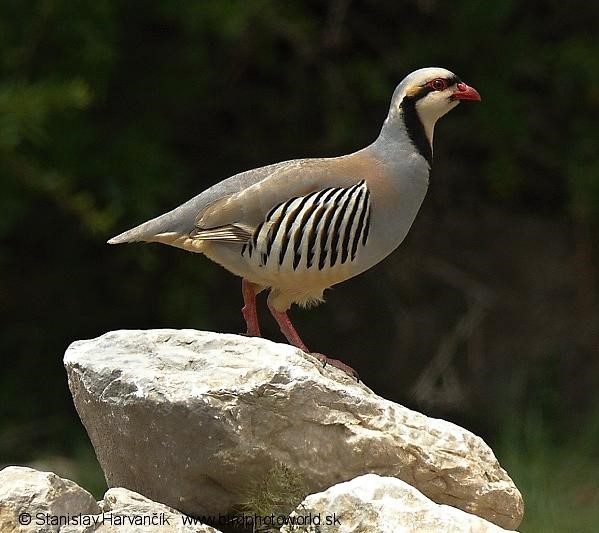Birdfinding.info ⇒ Locally common in several parts of its large range, including Cyprus, Israel, Armenia, Azerbaijan, northern Iran, northern Kyrgyzstan, southern Kazakhstan, and the northwestern Himalayas in eastern Jammu and Kashmir. In Greece, a convenient site is Mount Hymettus on the east side of Athens. In North America, areas where it can usually be found include: Richter Pass, British Columbia; Snake River Canyon, Washington; Antelope Island State Park, Utah; Red Rock Canyon, Nevada; and Honey Lake Wildlife Area and Noname Canyon in California. In Hawaii, consistent sites include: on Maui, the road up Haleakala, and on the Big Island, along Saddle Road at Pu’u Huluhulu.
Chukar
Alectoris chukar
Middle latitudes of Eurasia, where it occurs in dry, rocky, mainly mountainous terrain up to around 4,000 m elevation.
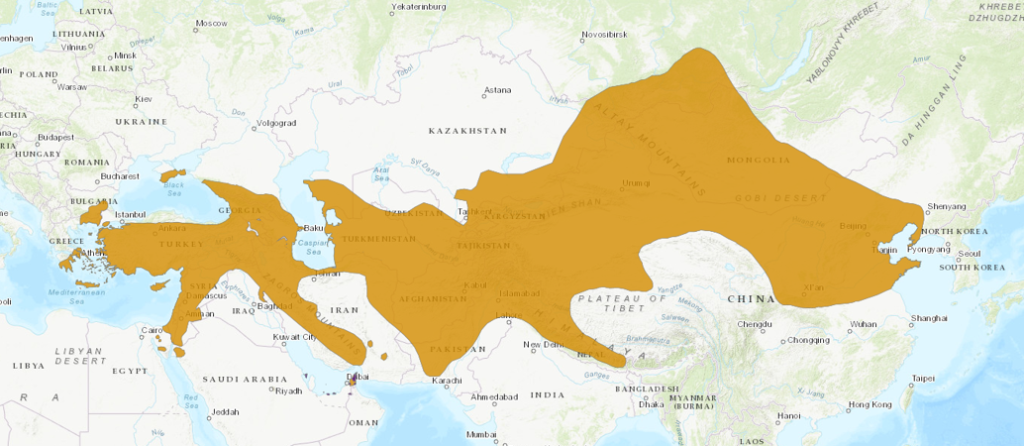
Approximate natural range of the Chukar. © BirdLife International 2019
Extensive natural range stretches from the Mediterranean to the Yellow Sea, shifting to progressively colder areas eastward. From southeastern Bulgaria, northeastern and southern Greece (including Crete and several Aegean islands), Cyprus, Israel, and the Sinai Peninsula, east through Turkey, the Middle East, Crimea, the Caucasus, most of the major mountain ranges of southwestern and central Asia, south to southern Iran, southern Pakistan, and the central Himalayas, north to the Mongolian Altai, and east across northern China to Liaoning and Shandong.
Widely introduced as a gamebird, and well-established across much of western North America from central British Columbia south through the intermontane region of the U.S. south to southern California, northern Arizona, and western Colorado, with isolated populations in central North Dakota and the California Channel Islands of San Nicolas and San Clemente.
Introduced populations are also established on the southeastern Hawaiian Islands from Molokai to the Big Island; on New Zealand’s South Island; on Robben Island, South Africa; and across the northern U.A.E. into northwestern Oman.
Feral individuals released by hunting organizations may be encountered nearly anywhere in the world.
Identification
A clay-brown-and-gray partridge with wavy black barring on its sides, a coral-red bill, and a bold black wreathlike band that forms a mask and collar and frames a cream-colored throat and upper chest.

Chukar. (Mount Arbel, HaZafon, Israel; March 19, 2017.) © Stanislav Harvančík

Chukar, showing clay-brown back and wings, and mostly gray rump and tail. (Mount Hymettus, Attiki, Greece; May 8, 2016.) © Nick Moore
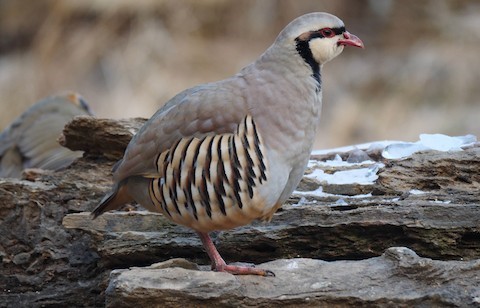
Chukar, showing complex, wavy barring pattern on the sides. (Quan Shui Wan, Henan, China; January 1, 2019.) © Josep del Hoyo

Chukar, showing wavy black barring on the sides and mixed gray-and-brownish upperparts. (Noname Canyon, Inyo County, California; March 31, 2017.) © Evan Rasmussen
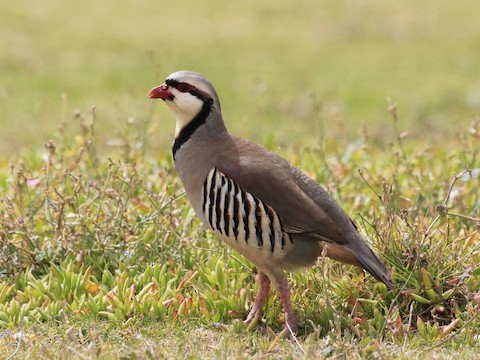
Chukar, showing mostly clay-brown wings and body plumage, and white-than-average throat and browline. (Green Mubazzarah, Abu Dhabi, United Arab Emirates; March 23, 2012.) © Christophe Gouraud
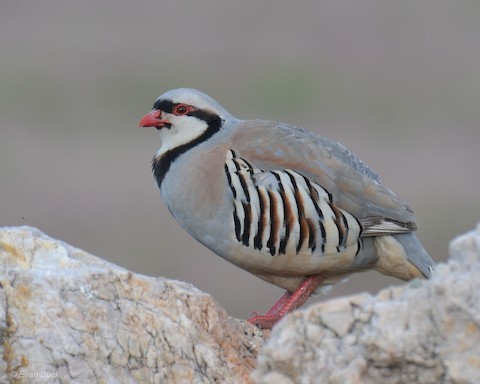
Chukar, showing mostly gray body plumage and partly brownish barring on the sides. (Antelope Island State Park, Davis County, Utah; June 1, 2013.) © Evan Buck

Chukar, showing blurry-edged black border and V-shaped pale area of throat and upper chest. (Kodachrome Basin State Park, Kane County, Utah; August 5, 2003.) © Skip Russell
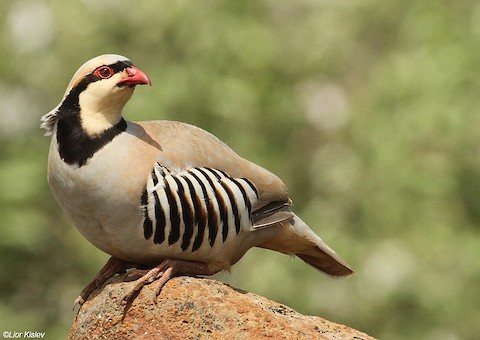
Chukar, showing broad black border and U-shaped pale area of throat and upper chest. (Bacha Valley, HaZafon, Israel; May 3, 2011.) © Lior Kislev
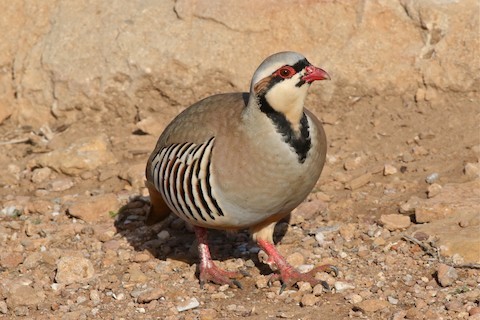
Chukar, appearing brownish overall and showing blurry-edged black border and V-shaped pale area of throat and upper chest. (Cape Sounio, Attiki, Greece; January 5, 2017.) © Johan Fagefors
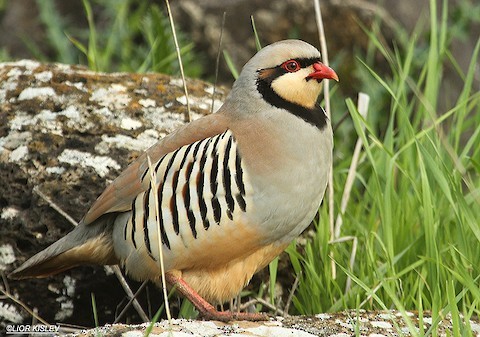
Chukar, appearing plump and showing bright buffy belly. (Ramot, HaZafon, Israel; March 1, 2012.) © Lior Kislev
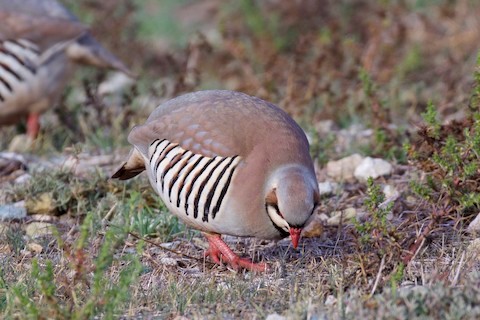
Chukar, dorsal view showing mostly brownish upperparts. (San Clemente Island, California; February 13, 2018.) © Nicole Desnoyers

Chukar, showing blurred black, gray, and brown barring on sides. (Spring Mountain Ranch State Park, Clark County, Nevada; November 23, 2006.) © Hal and Kristen Snyder
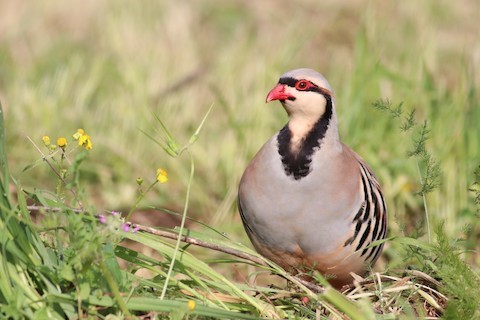
Chukar, showing blurry-edged black border and V-shaped pale area of throat and upper chest. (Tzova, Zova, Yerushalayim, Israel; March 2, 2019.) © Eliza Wein

Chukar, showing atypical thin black, double-barring on sides. (Ein Avdat Canyon, HaDarom, Israel; December 31, 2011.) © Christoph Moning

Chukar, showing atypically brown head, neck, and throat. (Kaisariani Aesthetic Forest, Attiki, Greece; July 5, 2018.) © Richard Greenhalgh
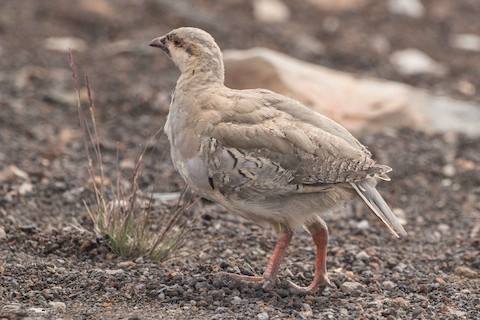
Chukar, juvenile with few recognizable features, but showing the early stages of a black mask. (Haleakala Visitor Center, Maui, Hawaii; August 14, 2018.) © Eric VanderWerf
Cf. Rock Partridge. Chukar and Rock Partridge are extremely similar and were formerly considered conspecific, but have been generally regarded as separate due to differences in their vocalizations and the fact that they remain distinct despite overlapping slightly in Bulgaria and Greece. Away from that zone, they are most likely to come into contact due to introductions of Chukar into Rock Partridge’s range.
The differences in their vocalizations are not always obvious, as both give excited series of harsh notes. Chukar’s voice is much deeper than Rock Partridge’s, more like the clucking of a chicken, and it tends to call in a more regular, accelerating pattern, whereas Rock Partridge’s voice is sharper, higher-pitched, sometimes screechy, and it calls in irregular, broken patterns.
The visible differences between them are not conspicuous and not entirely consistent. Comparative illustrations that show clear differences in the barring on their sides are misleading because both species are variable—as a general rule of thumb, Chukar has broader black bars with wavy edges, whereas Rock Partridge tends to have narrower bars with straighter edges. The bars are difficult to count accurately in the field, but Chukar generally has 10 to 12, whereas Rock Partridge typically has 12 to 14.
A more consistent difference is in the brow above the black mask: Rock Partridge has a well-defined, narrow white line that contrasts with its gray crown, whereas Chukar usually lacks distinct browlines, but instead has a broad, pale area that is usually cream-colored (not white) and gradually blends to gray and/or brownish on the crown.
Notes
Polytypic species consisting of 16 recognized subspecies. Formerly considered conspecific with Rock and Przevalski’s Partridges (A. graeca and magna), collectively known as the Chukar (A. graeca).
References
BirdLife International. 2019. Alectoris chukar (amended version of 2018 assessment). The IUCN Red List of Threatened Species 2019: e.T22678691A155454429. https://dx.doi.org/10.2305/IUCN.UK.2019-3.RLTS.T22678691A155454429.en (Accessed March 24, 2020.)
eBird. 2020. eBird: An online database of bird distribution and abundance. Cornell Lab of Ornithology, Ithaca, N.Y. http://www.ebird.org. (Accessed March 25, 2020.)
Hollom, P.A.D., R.F. Porter, S. Christensen, and I. Willis. 1988. Birds of the Middle East and North Africa. T & AD Poyser, Calton, England.
Madge, S., and P.J.K. McGowan. 2002. Pheasants, Partridges, and Grouse: A Guide to the Pheasants, Partridges, Quails, Grouse, Guineafowl, Buttonquails, and Sandgrouse of the World. Princeton University Press, Princeton, N.J.
McGowan, P.J.K., and G.M. Kirwan. 2020. Chukar (Alectoris chukar). In: del Hoyo, J., Elliott, A., Sargatal, J., Christie, D.A. & de Juana, E. (eds.). Handbook of the Birds of the World Alive. Lynx Edicions, Barcelona. https://www.hbw.com/node/53380. (Accessed March 25, 2020.)
Mullarney, K., L. Svensson, D. Zetterström, and P.J. Grant. 1999. Birds of Europe. Princeton University Press, Princeton, N.J.
Pratt, H.D. 1993. Enjoying Birds in Hawaii: A Birdfinding Guide to the Fiftieth State (Second Edition). Mutual Publishing, Honolulu, Hawaii.
Pyle, R.L., and P. Pyle. 2017. The Birds of the Hawaiian Islands: Occurrence, History, Distribution, and Status. Version 2 (January 1, 2017). http://hbs.bishopmuseum.org/birds/rlp-monograph/. B.P. Bishop Museum, Honolulu, Hawaii.
Xeno-Canto. 2020. Chukar Partridge – Alectoris chukar. https://www.xeno-canto.org/species/Alectoris-chukar. (Accessed March 25, 2020.)
